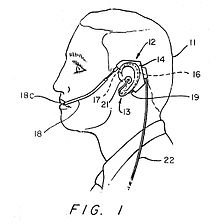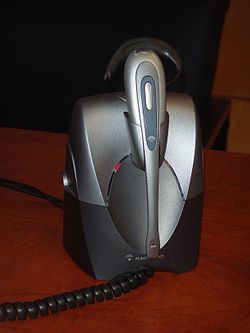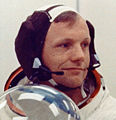- Plantronics
-
Plantronics, Inc. Type Public (NYSE: PLT) Industry Consumer electronics Founded 1961 Headquarters Santa Cruz, California Key people Ken Kannappan (Director, President & CEO) Products Corded and bluetooth headsets; audio solutions for business and consumers Revenue $683.6 million ( Fiscal 2010)[1] Employees Over 3,000 (2011)[2] Website www.plantronics.com/us// Plantronics is a global leader in audio communications for business and consumers, with products for unified communications, mobile use, gaming and music. Plantronics is a publicly traded company (NYSE: PLT) headquartered in Santa Cruz, California.
Contents
History
In the early 1960s, airline headsets were so large and clunky that many pilots had switched back to the use of handheld microphones for communications. The speed and complexity of jet airliners caused a need for the introduction of small, lightweight headsets into the cockpit. In 1961, United Airlines solicited new designs from anyone who was interested. Courtney Graham, a United Airline pilot, was one of the many who thought the heavy headsets should be replaced by something lighter. He collaborated with his pilot friend, Keith Larkin, to create a small, functional design which was robust enough to pass airlines standards. (Larkin had been working for a small company called Plane-Aids, a Japanese import company which offered spectacles and sunglasses that contained transistor radios in their temple pieces.)[3] The final design, incorporating two small hearing aid-style transducers attached to a headband was submitted to United Airline approval. UAL's approval of the innovative design caused Graham and Larkin to incorporate as Pacific Plantronics (now called Plantronics, Inc.) on May 18, 1961. They introduced the first lightweight communications headset, the MS-50, to the commercial marketplace in 1962.
In the mid 1960s, the Federal Aviation Agency selected Plantronics as the sole supplier of headsets for air traffic controllers, and thereafter was selected to supply headsets to the operators of the Bell Telephone company.
SPENCOMM and NASA
In 1961, NASA astronaut, Wally Schirra contacted Courtney Graham, a fellow pilot, to discuss creating a design for a small, lightweight headset to be used in the Mercury spacecraft.
Pacific Plantronics assembled its Space Environmental Communications (SPENCOMM) division to begin working on a reliable solution. SPENCOMM personnel traveled to NASA’s Manned Spacecraft Center (now Johnson Space Center) and Kennedy Space Center to meet with and get design feedback from Schirra and several other astronauts, including Gordon Cooper.[3]
Together, SPENCOMM and NASA spent only 11 days to create a working microphone design for space communications and Schirra was the first to use the new communication technology during the Mercury-Atlas 8 mission.[3] Significant redundancy was built into these headsets, as each microphone circuit had two transducers and each receiver had 5 transducers—in addition, the headsets were used in pairs. The use of these SPENCOMM-NASA headsets in astronaut space suits continued through the remainder of the Mercury program, the Apollo program and on to this day. The words spoken by U.S. astronaut Neil Armstrong as he stepped on the moon were transmitted through a Plantronics headset.
Early success for MS-50
As the primary result of the Pacific Plantronics partnership with NASA in the Space Program, the MS-50 headset gained nearly instant recognition in the communication marketplace. FAA, Western Electric and many companies with major telephone call centers adapted the MS-50 as a replacement for existing headsets.
MS-50 patent
On May 18, 1965, U.S. Pat. No. 3,184,556 was issued to W. K. Larkin for a
“ miniaturized headset wherein a hearing-aid size microphone transducer and a similarly miniaturized transducer are placed in a capsule mounted near the user's ear; speech is conducted to the microphone via an acoustic tube positioned near the user's mouth, while incoming communications emanating from the receiver are conducted to the user's ear via a second acoustic tube. ” The MS-50 was known commonly as a Larkin-type headset and it could be used with either a light headband or the temple bar of an eyeglass frame as the supporting member for the transducer housing.
In addition, users found that if a longer ear tube on the MS-50, the headband could hang around the user's neck. With this discovery, it became possible to rapidly adjust the headset to any of six different positions, increasing comfort for long-term wear. The six positions are on eyeglasses to the wearer's left or right, on headband to the left or right, and around the neck to the left or right. When the longer tube is on a headset worn on the headband in the traditional location, excess tube may be coiled around the headset support pad on the appropriate side, or left free and slack.
StarSet
In 1970, Ken Hutchings, an engineer who had joined Pacific Plantronics, patented a device which was marketed as the "StarSet". United States Patent 3548118 describes
“ A self-supporting headset having a housing which accommodtates a receiver and microphone. A flexible acoustic tube adapted to communicate between the auditory canal of the ear of the user and the receiver secured to the bottom of the housing, and an adjustable acoustic tube secured to the top of the housing with its distal end adapted to be disposed adjacent to the mouth of the user to transmit sound to the microphone. ” Wireless products
In the 1980s, Plantronics ventured into new areas to create a line of cordless products using infrared technology. Though the technology utilized was the same one being used by television remote controls, it had the advantage that the link did not require an Federal Communications Commission (FCC) telecommunications approval. One of the first products used the infrared beam to create a communications link between a small transmitter and a base unit which was connected to the telephone network. This product was the first "echo-free" speakerphone for use in conference rooms. The small transmitter could be handheld or clipped to clothing to ensure a good pickup of the speaker's voice.
Wireless office headsets
In 2003, Plantronics introduced the CS50 wireless headset for use on office phones. Since that time, wireless headsets including Plantronics' recent "CS70N" [6] have been widely adopted.
Mobile and Bluetooth mobile headsets
Plantronics manufactures a variety of mobile headsets, including a diverse line of Bluetooth headsets for mobile phones.
Computer and gaming headsets
Plantronics manufactures a variety of headsets for PC audio and online and console gaming via its GameCom and .Audio labels. The company created a special headset for the Xbox as a tie-in with the videogame Halo 2.
Corporate expansion & acquisitions
Plantronics has expanded into other segments of the audio equipment market through carefully targeted acquisitions.
Clarity
In 1986, Plantronics acquired Walker Equipment, Ringgold, Georgia, a manufacturer of amplified handsets and telephones. The Clarity products were created to enhance telephone usability for those with hearing impairment. Walker later acquired Ameriphone in 2002, and became Walker Ameriphone before changing its name to Clarity; Clarity is now US leading supplier of amplified telephones and is the first company in the world to utilize digital signal processing for audio processing in an amplified telephone [1].
Altec Lansing
In 2005, Plantronics acquired computer speaker manufacturer Altec Lansing for approximately $166 million.[7] In recent earnings and investor calls Plantronic's management have referred to this acquisition as a "turnaround" given disappointing financial results since purchase.[8]
Volume Logic
Plantronics later acquired Octiv, Inc. in March 2005 as one of its brands and renamed it as the Volume Logic division. They specialize in giving professionals an audio contouring toolset for crafting 5.1 surround sound soundtracks. Although the Volume Logic series of applications have since been discontinued, the underlying technology has adapted Plantronics telephony products to improve the sound quality of conference and personal phone calls.
Research
UC Gatekeeper Study
In April 2010, Plantronics released the Unified Communications (UC) Gatekeeper Study which surveyed IT professionals at Fortune 1000 companies regarding UC adoption and implementation.[9] The research found that 98 percent of Fortune 1000 companies were at least considering deploying UC. It also found that, at the time, the workforce had been split into nearly three equal types of employees: onsite employees (37 percent), road warrior (computing) (34 percent), and telecommuters (29 percent).[10]
How We Work: Communication Trends for Business Professionals
In September 2010, Plantronics released a second study titled, “How We Work: Communication Trends for Business Professionals.”[11] The research looked at how people use new forms of communication to get work done throughout the day. Over 1,800 knowledge workers were surveyed across Australia, China, India, Germany, the UK and the U.S.[12]
Notable findings:
- Overall communication has dramatically increased in the past five years with every form of communication listed showing increased use[13]
- 90% of knowledge workers work remotely at least some of the time[12]
- 54% of knowledge workers with access to softphones use them “frequently” or “all of the time”
- 99% of knowledge workers access email via a PC or Mac “frequently” or “all of the time”; 81% said they access email via a mobile device as often[14]
- 83% of knowledge workers dial-in to audio conferences “frequently” or “all of the time”
Gallery
References
- ^ http://hoovers.com/company/Plantronics_Inc/rjktyi-1.html
- ^ http://hoovers.com/company/Plantronics_Inc/rjktyi-1.html
- ^ a b c ""NASA Spinoff 2005"". http://www.sti.nasa.gov/tto/Spinoff2005/ch_9.html.
- ^ ""Larkin Patents MS-50"". http://www.freepatentsonline.com/4335281.html.
- ^ ""Self-supporting Headset"" (PDF). http://www.freepatentsonline.com/3548118.pdf.
- ^ CS70N
- ^ Plantronics To Acquire Altec Lansing
- ^ Plantronics )) Company )) Investor Relations
- ^ By Barry Margerum, The Voice of UC Blog. “[survey-says-fortune-1000-companies-quick-to-adopt-unified-communications Survey Says – Most Fortune 1000 Companies Quick to Adopt Unified Communications].” April 29, 2010. Retrieved October 5, 2010.
- ^ By Sam Diaz, ZDNet. “Survey: Scattered workforce drives need for smarter communications.” May 17, 2010. Retrieved October 5, 2010.
- ^ By Clay Hausmann, The Voice of UC Blog. “How We Work – Is Technology in Control?” September 30, 2010. Retrieved October 5, 2010.
- ^ a b By Alison Diana, InformationWeek. “Executives Demand Communications Arsenal.” September 30, 2010. Retrieved October 5, 2010.
- ^ By Zack Whittaker, ZDNet. “Study: 'Employees not sociable at work'; Gen Y needs to change everything.” October 3, 2010. Retrieved October 5, 2010.
- ^ By Tracey Schelmetic, TMCnet. “New Plantronics Study Reveals Global Trends in Business Communications.” October 1, 2010. Retrieved October 3, 2010.
- "About Plantronics". http://www.plantronics.com/north_america/en_US/company/index.jhtml;jsessionid=4ADZMRYPMWK42CQBGNUCFFAKAEZWSIV0. Retrieved 2006-03-11.
- "Clarity - Phone technology for the hard of hearing". http://www.clarityproducts.com/. Retrieved 2006-03-11.
- "Plantronics To Acquire Altec Lansing" (Press release). Altec Lansing Technologies, Inc.. July 11, 2005. http://www.alteclansing.com/press_news.asp?id=99®ion=northam.
External links
Categories:- Companies listed on the New York Stock Exchange
- Electronics companies of the United States
- Companies based in Santa Cruz County, California
- Headphones manufacturers
Wikimedia Foundation. 2010.





